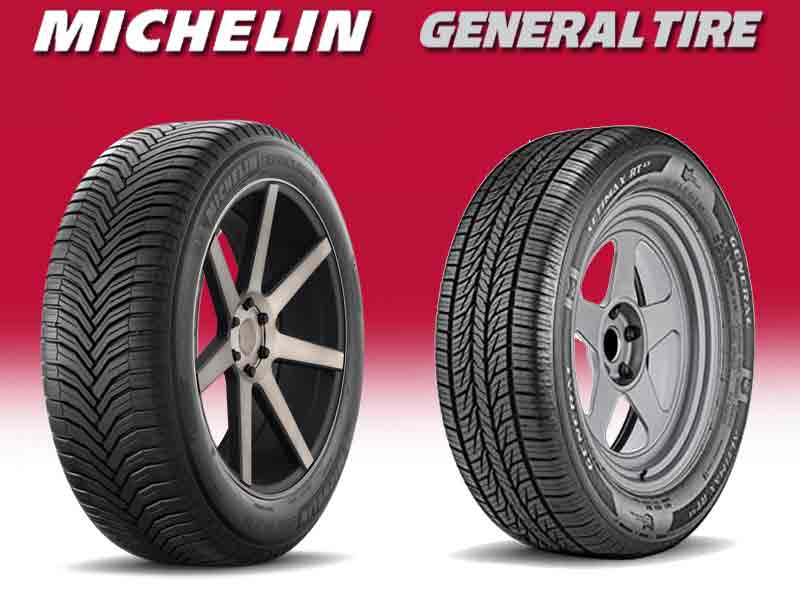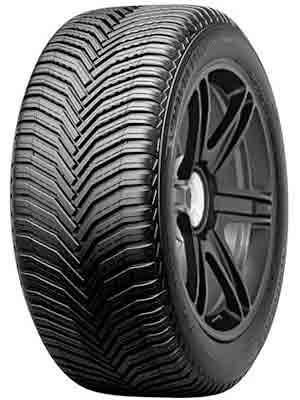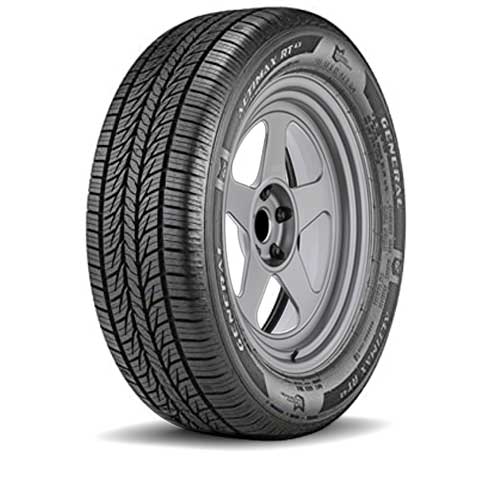For many drivers, the decision often comes down to the General Altimax RT43 and the Michelin CrossClimate 2. Both are renowned for their outstanding performance and sporty handling. Today, we will delve into a side-by-side comparison of these two top-tier tires. Ready to find out which one reigns supreme?
But first, let’s talk about where these tires should improve.

- Michelin CrossClimate 2 could improve on wet handling, fuel efficiency, tread noise, and tread life. Its heavier weight and larger shoulder grooves contribute to understeering and oversteering, while its softer compound leads to higher rolling resistance.
- General Altimax RT43, on the other side, could enhance its performance in areas of winter traction and ride comfort. Its stiffer rubber top layer and lack of sufficient biters and “swooping lugs” compromise on comfort and snow traction.
And so this brings us to the test scores, they achieved in our testing.
Table of Contents
Test Scores – Out of 10
| Altimax RT43 | Crossclimate 2 | |
| Dry Traction | 9 (Better) | 8 |
| Wet Traction | 9 (Better) | 7 |
| Snow Traction | 7 | 9 (Better) |
| Ice Traction | 7 | 9 (Better) |
| Fuel Efficiency | 8.5 (Better) | 8 |
| Tread Life | 8.5 (Better) | 7.5 |
| Ride Comfort | 8 | 8 |
Design Comparison
Comparing both tires, the Michelin CrossClimate 2 sports an innovative and meticulously designed directional tread pattern.

Its long, arching arms are neatly segmented by longitudinal grooves, creating a clear distinction between the central area and the shoulders.
Speaking of central lugs, these carry more features, as they besides having densely packed, present a blend of linear and undulating siping as well.
Moreover, these lugs also feature snow vices, which provide superb ice and snow grip.
The shoulder lugs on the other side are simple. They don’t carry any snow vices and interlocking sipes, though the siping slits are thicker here.
On the other side, the General Altimax RT43 features an symmetric pattern.

The tire is made more aggressive, as it’s lugs are equipped with very biting in-groove sharp notches.
But these are more prominent on the surrounding ribs, where the middle most rib is not as wide, and has smaller cuts in it.
The shoulders, though, on the tire has a more simplistic approach.
Here they only feature mere laterally oriented rectilinear sipes.
Wet Traction
Wet performance is primarily a function of hydroplaning resistance and wet grip.
Let’s start with grip.
Wet Grip
Wet grip is predominantly influenced by sipes. And here, the Michelin CrossClimate 2 falls short, due to a smaller number of sipes available on its tread, particularly around the tire’s shoulders, adversely affecting its overall handling competence on wet surfaces.
This is because wet handling depends on the sipes on shoulders. These sipes basically suck up water particles coming directly underneath the lugs. They contact/expand to create vacuum, acting as water absorbers
But since the tire has interlocking sipes in the middle part of the tread, you still get superior directional grip on this tire, which gets measured with wet braking efficacy.
But still, as the wet handling is the overall major wet performance factor here, the overall traction is seen better on Altimax RT43.
Hydroplaning
While the CrossClimate 2 may not excel in wet handling, it distinguishes itself through superior hydroplaning resistance.
And its superior float speeds can be attributed to its unique V-shaped tread design, efficiently facilitating water displacement through its streamlined tread voids.
Whereas the General Altimax RT43 faces some challenges due to its continuous longitudinal ribs. These ribs, closely aligned, impede efficient water expulsion, particularly sideways.
Grip and Handling
Similar to its performance in wet traction, the CrossClimate 2 slightly outperforms other tires in terms of grip, primarily due to its densely packed lugs in the central area. These densely arranged lugs enhance grip and effectively decrease braking distances.
However, the larger shoulder grooves of the CrossClimate 2 seem to fall short in providing sufficient handling. This is fundamentally about how much of the tire’s rubber actually makes contact with the road.
When the tire rolls straight, the central area has the most contact with the road, thus contributing significantly to the directional grip. Conversely, when the tire is cornering, the shoulders bear the brunt of the weight due to inertia, which informs us about its handling capabilities.
There is another aspect to consider as well. The CrossClimate 2, with its heavier weight, tends to cause more understeering and oversteering, and this also compromises its handling performance.
Winter Performance
The CrossClimate 2 shines in winter traction, where its V-shaped lugs exhibit superior snow/slush/ice clearance abilities, producing superior momentum on diverse snowy terrains.
Moreover, these lugs also have snow vices in them, a long with thick siping slits. And both of these features are designed to hold on to the snow particles, so that the tire can make a better snow to snow contact.
(This type of contact is very significant, as snow sticks better on snow, then tread’s rubber).
On the other side, the Altimax RT43 struggles due to a lack of sufficient biters, and since the tire also does not have any “swooping lugs”, you also don’t get to see as effective of the snow paddling too.
And yes one more thing, the tire also lacks the thermal adaptability of its rubber, meaning, its rubber tends to freeze up more quickly with snowy temperatures, comparatively.
Fuel Efficiency
Fuel efficiency is influenced by numerous factors such as weight, tread composition, and design.
And considering all, it’s not surprising that the heavier CrossClimate 2, with its softer tread compound, suffers more here, due to its greater rolling resistance.
Basically, the heavier weight pushes its softer compound, to rub against the road with a greater force, comparatively. In other words, its lugs don’t want to unstuck so easily, as they meet up with the ground.
Whereas the lighter General Altimax RT43 provides superior fuel economy, where it’s longitudinally aligned more streamlined lugs are also helping it roll (straight), with more ease, keeping friction to the minimum needed levels.
Feel of Ride
Ride quality is a function of noise levels, road shock absorption and the overall steering response of the tire.
Now its already explained that the Altimax shows superior steering feedback due to its superior under and over steering balance, but how well does this tire do in other two areas? Let’s find out.
Tread Noise
Noise is made when air particles collide with the tread walls. And most of the air enters the tire through shoulders.
That’s why the General Altimax RT43 gets to be quieter here, as it leverages blockers between shoulder lugs not allowing too much air to get inside, in the first palace.
Moreover, it also features superior pitch sequencing to mitigate sound resonance (where variable tones are generated as air particles hit the blocks, and them creating different frequencies try to cancel out each other).
On the other side, the Michelin CrossClimate 2 is not loud by any means, its slightly lighter on the paper when compared to RT43, mainly due to its wider shoulder voids.
On-Road Vibrations
But wait, ride comfort is also influenced by a tire’s composition, and here the CrossClimate 2, with its softer tread rubber and softer inner cap ply, absorbs road shocks more effectively, enhancing ride comfort, in that manner.
Meanwhile, the Altimax RT43, with its stiffer rubber top layer, experiences a slight dip in comfort levels despite its flexible internal polyester casing.
So basically, General’s tire offer superior handling stability, while the Crossclimate is better at impact comfort.
Tread Life
Rolling resistance plays a significant role in tread life as well (just like the fuel economy).
And so here the General Altimax RT43 again shows up better, with its lighter weight, and more uniform tread design through out.
Whereas the Crossclimate with greater weight, pushes its lugs to burn at a faster rate, as they rub against the road.
And yes, its softer compound isn’t helping that either.
Summing Up
Michelin CrossClimate 2 excels in:
- Directional Grip: Its densely packed lugs in the central area, along with interlocking sipes, enhance grip and effectively decrease braking distances.
- Winter Performance: Its V-shaped lugs and snow vices in combination with thick siping slits provide superior traction in snowy conditions, enabling better “snow-to-snow” contact and effective snow displacement.
- Hydroplaning Resistance: The unique V-shaped tread design facilitates efficient water displacement, which results in superior hydroplaning resistance.
- Ride Comfort: The softer tread rubber and inner cap ply absorb road shocks effectively, enhancing the ride comfort.
General Altimax RT43 excels in:
- Handling Stability: Thanks to a better under and over steering balance, the tire provides superior steering feedback.
- Fuel Efficiency: Its lighter weight and longitudinally aligned lugs keep friction to a minimum, thus offering superior fuel economy.
- Tread Noise: The use of blockers between shoulder lugs and superior pitch sequencing results in a quieter ride.
- Tread Life: A lighter weight and more uniform tread design contribute to longer tread life.
- Wet Traction: Despite its shortcomings in terms of hydroplaning, its greater number of sipes and overall structure provide superior overall traction on wet surfaces.